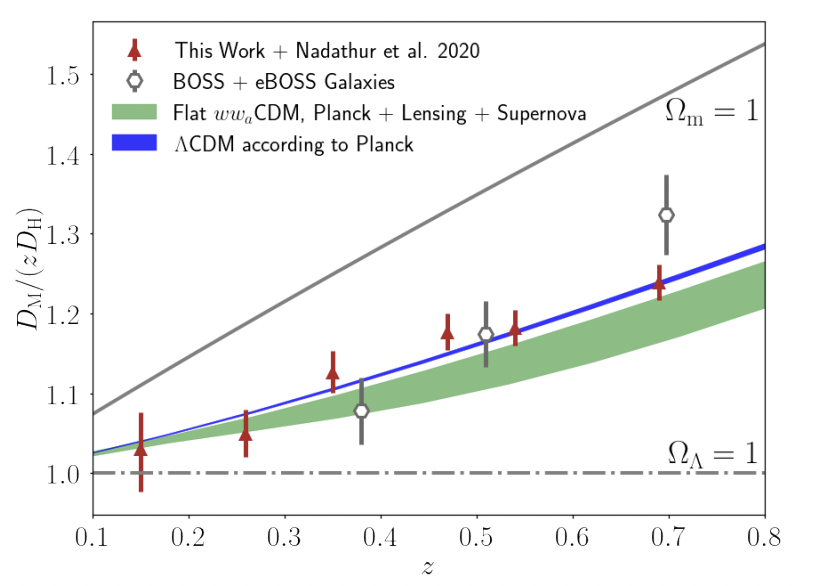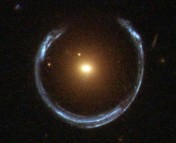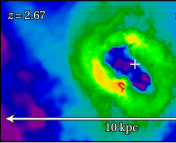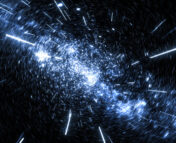Title: Measurements of cosmic expansion and growth rate of structure from voids in the Sloan Digital Sky Survey between redshift 0.07 and 1.0
Authors: Alex Woodfinden, Seshadri Nadathur, Will J. Percival, Slađana Radinović, Elena Massara, Hans A. Winther
First Author’s Institution: Waterloo Centre for Astrophysics, University of Waterloo
Status: Submitted to ArXiv [12 May 2022]
Pitch: BAOs are Cool
Cosmologists love Baryon Acoustic Oscillations (BAO), and here’s why you should too. Back when the universe was just a baby made out of hot plasma, a battle between gravity and radiation was raging on. Small overdensities in the hot plasma fought to collapse under gravity, while tightly coupled radiation provided pressure that resisted this collapse. The outcome of this battle were oscillations of matter that spread out across the plasma, almost like ripples in a pond. As the universe began to cool, radiation no longer provided support against gravitational collapse, and overdensities of matter contained within these ripples could finally collapse into galaxy clusters. These ripple-like patterns of galaxy clusters are known as BAOs, and they’re extremely important to cosmologists because their size and properties depend on the details of our universe’s composition. Precise measurements of these BAOs can provide constraints on important cosmological parameters such as the amount of baryonic matter, dark matter, and dark energy in the universe. Additionally, monitoring the size of BAOs over a wide range of redshifts can be used to measure how the expansion rate of the universe changes across cosmic time. Given everything that we can learn from studying BAOs, it’s no wonder why cosmologists have been using them as cosmological probes for decades. Have I sold you on BAOs yet?
Pitch 2: So are Cosmic Voids
If so, I have another cosmological probe to sell you on: cosmic voids. If BAOs represent overdense regions in the universe, it’s no surprise that there are regions with extremely low densities as well. These cosmic voids are around a tenth of the average density of the universe, and they’re massive, making up around 90% of our universe. And, as it turns out, these voids are just as exciting to test parameters of cosmology as BAOs are! The properties of voids are sensitive to everything from dark energy and modified gravity, to structure growth and galaxy formation. Who knew you could get something from studying nothing!

But most important for today’s discussion is the information encoded within the void-galaxy cross-correlation function. While it sounds like a mouthful, this function really just describes the properties, such as the density and peculiar velocities, of galaxies surrounding voids. This statistical property is particularly important as it can characterize both red-shift-space distortions (RSDs), and the Alcock-Paczyński (AP) effect. Astronomers use an object’s velocity to determine its redshift, and RSDs are simply biases in our redshift measurement due to an additional peculiar velocity component. Since peculiar velocities are dependent on local gravitational interactions, accurately characterizing RSDs can tell us a lot about the properties of matter in our universe, such as the growth rate of structure. The AP effect, on the other hand, is a distortion of the shape of a distribution of galaxy clusters. If we assume galaxy clusters are distributed like a sphere around voids, the AP effect can make the distribution of clusters appear flattened or elongated if astronomers make incorrect assumptions about the geometry of the universe. Analysis of these distortions provides astronomers with measurements of what is known as the Alcock-Paczyński distance ratio, which is the ratio between the comoving angular diameter distance and the Hubble distance. This is particularly exciting for the study of cosmic voids, as they should be able to constraint this distance ratio even more precisely than BAOs can. All in all, cosmic voids are a novel probe of the properties of our universe. Not sold yet? Well, let’s let the results of today’s paper do the talking then!
The Proof is in the Cosmic Void
The authors of today’s paper examined the cross-correlation of galaxies and cosmic voids to unravel the wealth of cosmological information packed within them. After careful and rigorous treatment of both selection and systematic errors that can arise from the analysis of cosmic voids, the authors found exciting results. First, the authors found that cosmic voids alone can constrain the value of the growth rate of structure just as precisely as BAOs can (Figure 1). While this is not a novel result, this precision points to the fact that voids are a great tool to use in combination with BAOs to get better measurements of cosmological parameters than either of them can do alone. But, perhaps even more compelling is the fact that the author’s results also confirm that cosmic voids do beat BAOs when it comes to measuring the AP distance ratio (Figure 2). Such results demonstrate the importance of voids as cosmological probes, and support a powerful new avenue for cosmologists to explore to unlock the mysteries of our universe. And, as the cherry on top of it all, there are new galaxy surveys such as DESI and Euclid coming up in the near future, which will probe much larger volumes of the universe over a larger redshift range. Watch out world, precision cosmology is about to get even more precise!

Astrobite edited by Roel Lefever
Featured image credit: FORS Team, 8.2-meter VLT Antu, ESO




